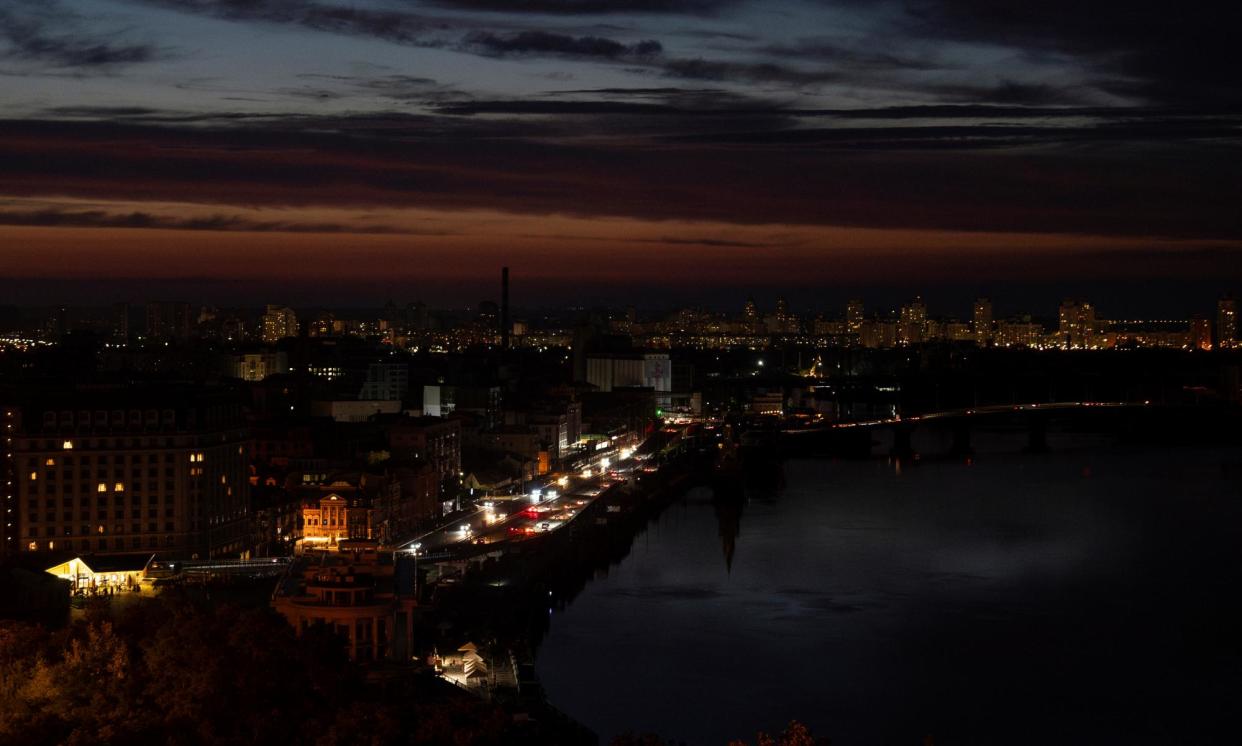Ukraine endures widespread blackouts as Russia attacks critical infrastructure

Ukrainians are having to cope with widespread emergency blackouts as Russia continues to pound critical infrastructure.
In recent months, Moscow has intensified its attacks on Ukraine’s energy grid. On Friday night, energy facilities came under a “massive attack”, Ukraine’s energy ministry said. Several workers were injured as a result of shelling at one of the facilities.
“The situation in the energy sector remains difficult,” the ministry said in a statement on Saturday.
Volodomyr Zelenksiy said this month that Russia had damaged or destroyed more than half of Ukraine’s power generation, causing the worst rolling blackouts since the full-scale invasion in 2022.
Ukraine began implementing rolling blackouts on 15 May, disconnecting entire districts of the capital from the power grid to save energy.
In an address on Saturday evening, Zelenskiy urged Ukraine’s western allies to speed up deliveries of air defences. “Modern air defence systems for Ukraine – such as Patriots, accelerated training of our pilots for F-16s, and most importantly, sufficient range for our weapons – are truly necessary,” the Ukrainian president said.
Ukraine has at least four Patriot systems, provided by the US and Germany. Since Zelenskiy made repeated pleas for additional defence weapons, Germany, Romania and the US have each pledged to send Kyiv a Patriot system.
On Friday the Netherlands announced that it, in collaboration with another, unnamed country, would supply Ukraine with an additional Patriot missile system. Zelenskiy has said Ukraine needs seven to “secure our main urban agglomerations” against Russian missile attacks.
Until these deliveries arrive, it is expected that systematic attacks on power infrastructure will continue, forcing people in Kyiv to improvise.
Oleksandr Babich, 34, an IT worker, said: “I can’t work from my office any more and now roam from cafe to cafe to try to find a quiet spot with electricity. At night I light up candles. Russia is trying to take us back into the stone age.”
Restaurants, hotels and shopping centres have invested in generators, whose constant loud hum is now a fixture in the capital.
While the long summer light made the situation somewhat bearable, Babich said, many fear the colder winter months to come, when demand for electricity will surge.
Serhiy Kovalenko, the chief executive of the energy supplier Yasno, said last week that Ukrainians may have electricity for six or seven hours a day in winter if the electricity deficit remained at 35%.
Olha Bondarenko, 46, who runs a smoothie bar in the city centre, said she had adjusted her menu to leave out fruits that require more time for blending, and squeezed other fruits by hand. “Our blenders consume so much energy,” she said. “Luckily, our clients are understanding of the situation because everyone is going through the same problems.”
On Sunday Moscow accused Ukraine of attacking the city of Sevastopol, on the Russian-occupied Crimean peninsula, with five US-supplied Atacms missiles, killing five people and injuring about 100 more.
Russia’s defence ministry said Ukraine had struck “the civilian infrastructure of the city of Sevastopol with Atacms tactical missiles supplied by the United States and equipped with cluster warheads”.
The defence ministry said the US, which supplied Ukraine with Atacms missiles, was primarily responsible for the missile attack and vowed to retaliate.
Footage circulating on social media showed beachgoers in Crimea, a popular summer destination for Russians, hastily fleeing after what appeared to be an explosion.
Mikhail Razvozhayev, the Russian-installed governor of Sevastopol, said about 100 people were injured by falling shrapnel. Ukraine has not yet commented on the strike.
Ukraine has also claimed to have destroyed a Russian warehouse used for launching Iranian-made kamikaze drones and training soldiers, reportedly killing several people in the attack. Satellite images published by the Ukrainian Navy showed a heavily damaged building which Kyiv said was used to store the drones.
Ukrainian firepower has been somewhat improving since US lawmakers approved a critical military aid package in April. The west’s decisions to allow Ukraine to strike Russian territory with its weaponry have halted Russia’s push along the north-east front near Ukraine’s second largest city, Kharkiv.
Ukraine has even managed to push Russian positions back, recently recapturing areas south-west of Vovchansk, a prime target of Russia’s advances near Kharkiv.
Lt Col Nazar Voloshyn, of the Khortytsia operational strategic group of forces based in Kharkiv, said in a statement on Telegram on Saturday that his unit had recorded a withdrawal of Russian troops near Liptsi and Tykhe, two districts that have experienced some of the heaviest fighting as part of Russia’s Kharkiv offensive.
After delays in delivery and training pilots and ground staff, Ukraine is expected to receive from the west the first batch of F-16 fighter jets this summer, which it is hoped will protect Kharkiv from Russian bombs.
For people in Kharkiv, those deliveries could not come fast enough. On Saturday a Russian aerial bomb hit a five-storey residential building in the city, killing at least three people and wounding more than 55, officials said.
Currently, Kyiv is allowed to use US weapons only as long as they are limited to shelling Russian forces directly attacking them across the border. Ukrainian generals have been pushing for those restrictions to be lifted to enable strikes of particular high-value targets such as airbases and command centres deeper inside Russia using long-range weapons with a range of more than 62 miles.
Meanwhile, Ukraine has continued its strikes on Russian oil refineries as Kyiv aims to disrupt the infrastructure supplying the Russian military.
Russian authorities said more than 30 drones were shot down over the country’s western regions between Saturday night and Sunday morning. Earlier in the week, Kyiv announced that it had struck three oil refineries inside southern Russia.


